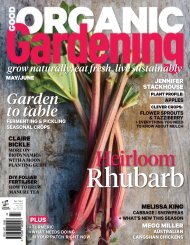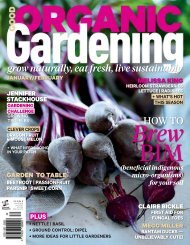6. Good Organic Gardening - November-December 2016 AvxHome.in
6. Good Organic Gardening - November-December 2016 AvxHome.in
6. Good Organic Gardening - November-December 2016 AvxHome.in
You also want an ePaper? Increase the reach of your titles
YUMPU automatically turns print PDFs into web optimized ePapers that Google loves.
TIME TO PLANT | Scarlet runner bean<br />
- <strong>in</strong> the -<br />
vegie patch<br />
Bean there<br />
If you live <strong>in</strong> a cooler<br />
area, the scarlet runner<br />
could be the bean for you<br />
Words Jennifer Stackhouse<br />
When we moved <strong>in</strong>to our coolclimate<br />
Tasmanian garden<br />
<strong>in</strong> w<strong>in</strong>ter, the ornamental<br />
garden was dormant, but the<br />
large vegetable garden was well stocked<br />
with leftover summer crops. We were able<br />
to harvest potatoes, Brussels sprouts<br />
and silver beet, and collect eggs from the<br />
chook shed. Enough for a meal <strong>in</strong> itself, but<br />
there was one more <strong>in</strong>gredient the garden<br />
provided: beans. Four tall bamboo tripods<br />
were hung with dried bean pods filled with<br />
handsome violet and black beans.<br />
The summer’s crop of scarlet runner<br />
beans had been left to dry and we were the<br />
beneficiaries. We’ve enjoyed dried scarlet<br />
runner beans each year s<strong>in</strong>ce. The beans<br />
grow up dur<strong>in</strong>g summer, sprout<strong>in</strong>g from<br />
large tubers that rema<strong>in</strong> <strong>in</strong> the ground,<br />
and I replant seeds each year, sow<strong>in</strong>g one<br />
or two at the base o f each leg of the bean<br />
tripod. Over time, the older beans are less<br />
productive, which is why it’s a smart move to<br />
re-sow some new ones each year.<br />
The v<strong>in</strong>es tw<strong>in</strong>e up their supports, soon<br />
reach<strong>in</strong>g the top. By mid-summer, they are<br />
covered with clusters of decorative red<br />
flowers, which form thick, green runner<br />
beans. They could be harvested at this stage<br />
and eaten as green beans, but I prefer to<br />
leave them to swell and dry on the v<strong>in</strong>e then<br />
harvest the pods <strong>in</strong> autumn and w<strong>in</strong>ter.<br />
The v<strong>in</strong>es tw<strong>in</strong>e up<br />
their supports, soon<br />
reach<strong>in</strong>g the top. By<br />
mid-summer, they are<br />
covered with clusters of<br />
decorative red flowers,<br />
which form thick,<br />
green runner beans.<br />
The scarlet runner bean is best suited to<br />
areas with cool summers. In warmer climes,<br />
they grow strongly and may flower but may<br />
not form pods and won’t develop a thick,<br />
starchy root. Late sow<strong>in</strong>gs may set beans <strong>in</strong><br />
autumn <strong>in</strong> temperate zones but not reliably.<br />
The lush green leaves and scarlet<br />
flowers make this productive v<strong>in</strong>e very<br />
attractive. It can be grown on an arch or<br />
trellis where its flowers can be enjoyed. In<br />
gardens <strong>in</strong> the United States, the scarlet<br />
runner bean attracts humm<strong>in</strong>gbirds.<br />
44 | <strong>Good</strong> <strong>Organic</strong> <strong>Garden<strong>in</strong>g</strong>

















